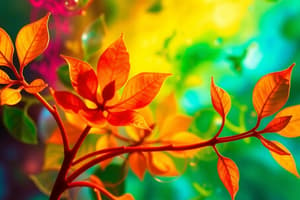Podcast
Questions and Answers
Which process occurs due to the photolysis of water during non-cyclic photophosphorylation?
Which process occurs due to the photolysis of water during non-cyclic photophosphorylation?
- Formation of glucose
- Release of oxygen (correct)
- Reduction of NADP+ to NADH
- Production of ATP
What is produced at the end of the non-cyclic photophosphorylation process?
What is produced at the end of the non-cyclic photophosphorylation process?
- Glucose and CO2
- FADH2 and oxygen
- ATP and NADPH (correct)
- ADP and water
What is the primary location where non-cyclic photophosphorylation occurs?
What is the primary location where non-cyclic photophosphorylation occurs?
- Cytoplasm
- Inner mitochondrial membrane
- Thylakoid membrane (correct)
- Chloroplast stroma
In non-cyclic photophosphorylation, electrons move through which of the following?
In non-cyclic photophosphorylation, electrons move through which of the following?
What role do protons ($H^{+}$) play during ATP formation in non-cyclic photophosphorylation?
What role do protons ($H^{+}$) play during ATP formation in non-cyclic photophosphorylation?
Which photosystem is involved in the absorption of light and subsequent electron excitation in this process?
Which photosystem is involved in the absorption of light and subsequent electron excitation in this process?
Which molecule is formed by the combination of electrons, NADP+, and hydrogen ions at the end of non-cyclic photophosphorylation?
Which molecule is formed by the combination of electrons, NADP+, and hydrogen ions at the end of non-cyclic photophosphorylation?
During non-cyclic photophosphorylation, which energy-rich molecule is produced as a result of the flow of electrons down the electron transport chain?
During non-cyclic photophosphorylation, which energy-rich molecule is produced as a result of the flow of electrons down the electron transport chain?
Flashcards
Light Absorption in Non-Cyclic Photophosphorylation
Light Absorption in Non-Cyclic Photophosphorylation
Photosystem II absorbs light energy, boosting electrons to a higher energy level.
Electron Transfer in Non-Cyclic Photophosphorylation
Electron Transfer in Non-Cyclic Photophosphorylation
Excited electrons in photosystem II are passed along an electron transport chain (ETC) to photosystem I.
Water Splitting in Non-Cyclic Photophosphorylation
Water Splitting in Non-Cyclic Photophosphorylation
Water molecules are split (photolysis) to replace the electrons lost from photosystem II, producing oxygen and hydrogen ions (H+).
Electron Transport and Proton Pumping in Non-Cyclic Photophosphorylation
Electron Transport and Proton Pumping in Non-Cyclic Photophosphorylation
Signup and view all the flashcards
ATP Synthesis in Non-Cyclic Photophosphorylation
ATP Synthesis in Non-Cyclic Photophosphorylation
Signup and view all the flashcards
NADPH Formation in Non-Cyclic Photophosphorylation
NADPH Formation in Non-Cyclic Photophosphorylation
Signup and view all the flashcards
Electron Flow in Non-Cyclic Photophosphorylation
Electron Flow in Non-Cyclic Photophosphorylation
Signup and view all the flashcards
Location of Non-Cyclic Photophosphorylation
Location of Non-Cyclic Photophosphorylation
Signup and view all the flashcards
Study Notes
Non-cyclic Photophosphorylation
- Occurs in photosystems I and II
- Photolysis of water occurs
- Oxygen is produced
- ATP and NADPH are synthesized
- Electrons move through an electron transport chain
- Electrons move in a linear fashion, not a cycle
Cyclic Photophosphorylation
- Occurs only in photosystem I (P700)
- No photolysis of water
- No oxygen is produced
- Only ATP is synthesized
- Electrons do not move in a closed circle
Differences between Cyclic and Non-cyclic Photophosphorylation
- Cyclic photophosphorylation only involves photosystem I
- Non-cyclic photophosphorylation involves both photosystems I and II
- Cyclic photophosphorylation does not produce oxygen
- Non-cyclic photophosphorylation produces oxygen
- Cyclic photophosphorylation only synthesizes ATP
- Non-cyclic photophosphorylation synthesizes both ATP and NADPH
Photosystems
- Photosystems are protein complexes containing chlorophyll molecules
- Chlorophyll absorbs light energy to excite electrons
- Excited electrons are passed along an electron transport chain
- There are two types of photosystems: photosystem I (P700) and photosystem II (P680)
Electron Transport Chain
- Electrons are transferred from one component to another in the chain
- Energy from electron transfer is used to pump protons into the thylakoid lumen
- This creates a proton gradient across the membrane
- The proton gradient drives ATP synthesis
ATP Synthesis
- ATP synthase uses the proton gradient to phosphorylate ADP to ATP
- ATP is the energy currency of the cell
Summary of Non-cyclic Photophosphorylation (Diagram Explanation)
- Light excites electrons in photosystem II (P680).
- Electrons are passed down an electron transport chain.
- The energy released from this transfer is used to pump protons into the thylakoid lumen, creating a proton gradient.
- Electrons are transferred to photosystem I (P700), where they are re-energized by light.
- Electrons are passed to NADP+, reducing it to NADPH.
- Protons flow through ATP synthase, driving the synthesis of ATP from ADP and inorganic phosphate (Pi).
- Water molecules are split to replace the electrons lost from photosystem II, and oxygen is released as a byproduct (H2O → 2H+ + ½O2)
Studying That Suits You
Use AI to generate personalized quizzes and flashcards to suit your learning preferences.





